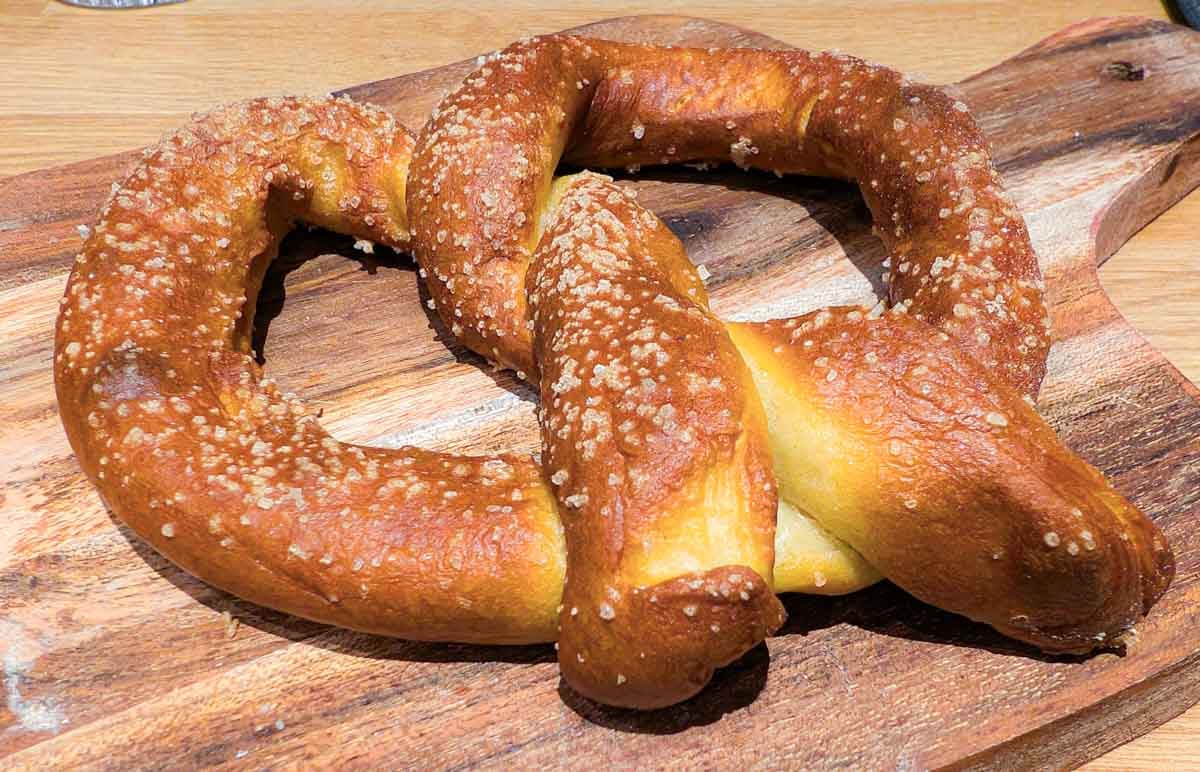
Homemade pretzels are not just a snack; they’re a culinary adventure that combines tradition, creativity, and satisfaction. Pretzels are a big favourite for grabbing on the go, be it when out shopping or from a snack bar on travels. Making pretzels at home allows you to customize flavours and shapes to your liking.
Let’s look through the history of pretzels, the ingredients needed, and a step-by-step guide recipe to making them with some topping ideas and serving suggestions
History of Pretzels
The origin of pretzels can be traced back to ancient Europe, with various theories suggesting they were created in the early days of Christianity. The shape of the pretzel, resembles arms crossed in prayer or the shape of The Holy Trinity. The exact origin is unknown but of course there are many theories and all still debated.
Italian Monk Origin
One theory goes that in the 7th Century and Italian Monk wanted to motivate and incentify his students. He made some dough, rolled it in the round shape of hands praying and baked it. As he gave them to the students he siad ‘pretiola’ which means ‘little rewards’.
Germany Origins
Another theory is that they came from German bakers, in the area of Bavaria. It had grown over time from a type of bread that the Romans ate, pretiolas. Then evolved over time. In Germany it is called a ‘Brezel’ which could be a derivation of Latin ‘bracchiola’ which means ‘little arms’ or ‘bracellus (bracelet).
To this day, Germany is particularly renowned for its contribution to pretzel culture, where festivals and fairs often feature these delicious treats.
To The USA
Pretzels headed to the United States during 19th century when German immigrants settled in Pennsylvania. They were known as the pennsylvania dutch.
As the popularity grew into the 20th century the pretzel started appearing more in more states. Together with new modern mass production abilities they became big in places like New York, Philadelphia and Chicago.
Pennsylvania still provides over 80% of US pretzels with the average US citizen consuming 0.7 kg of pretzels annually.
This all lead to the rise of the soft pretzel as a street food favorite. Today, pretzels are beloved worldwide and have become an iconic snack at sports events, fairs, and bakeries.

Different Types of Pretzels Around the World
While the classic twisted pretzel is widely recognized, variations exist globally. In Belgium, for instance, you might find ‘gezouten’ pretzels, which are characterized by their saltiness and often served with mustard.
Many countries have a variation on the pretzel. Hungary has a variation called a perec. In Sweden they have the kringlor which is more sweetened.
There is also the hard pretzel or pretzel sticks that are a favourite salty snack around the world.
In the United States, there’s a significant focus on soft pretzels, typically served warm and with a variety of toppings. Meanwhile, the crunchy pretzel shape can be found in snack aisles across many countries, offering a delightful crunch that pairs well with dips and beverages.
The Recipe
Equipment required. Large bowl, wooden spoon, whisk, saucepan and baking tray with greaseproof paper.
Optional Ingredients for Flavour Variations
Once you master the basic pretzel dough, you can experiment with various flavourings. Consider adding:
- Garlic powder or onion powder for savory pretzels
- Cheddar cheese for a cheesy twist
- Cinnamon and sugar for a sweet version
These optional ingredients can help you create pretzels that suit any taste preference.
Topping Ideas to Elevate Your Pretzels
Classic Salt Topping
The traditional salt topping is simple yet effective. Coarse sea salt adds a delightful crunch and enhances the pretzel’s flavor. For an elevated experience, try infusing the salt with herbs or spices. A sprinkle of garlic salt or everything bagel seasoning can add a unique twist to classic pretzels.
Sweet Variations
If you have a sweet tooth, consider sprinkling cinnamon sugar on your pretzels after baking. For an even sweeter treat, drizzle a simple glaze made from powdered sugar and milk over the cooled pretzels. This addition transforms them into a dessert that is perfect for parties or gatherings.
Cheesy and Savoury Options
For those who prefer a savory bite, try topping your pretzels with shredded cheese before baking. Cheddar, mozzarella, or even pepper jack can make for delicious variations. You can also incorporate toppings like jalapeños, bacon bits, or fresh herbs to customize your pretzels to your liking.
Serving Suggestions
Pairing with Dips
Homemade pretzels are perfect for dipping. A classic mustard sauce complements the salty flavor, while a smooth cheese sauce or beer cheese dip can take your pretzel experience to the next level. Additionally, a sweet, creamy dip made from cream cheese and powdered sugar pairs beautifully with sweet pretzels.
Storage and Reheating Tips
How to Store Leftover Pretzels
If you have leftover pretzels, store them in an airtight container at room temperature for 1-2 days. For longer storage, consider freezing them. Wrap each pretzel tightly in plastic wrap and place them in a freezer-safe bag. They can be frozen for up to 3 months.
Best Ways to Reheat Pretzels
To enjoy your pretzels after they’ve been stored, reheat them in the oven for about 5-10 minutes at 350°F (175°C) to restore their crispness. If you’re in a hurry, you can use a microwave, but be aware that this method may make them chewy rather than crispy.
Discover more from reviewer4you.com
Subscribe to get the latest posts to your email.





